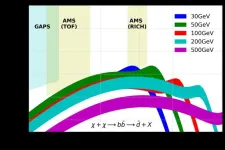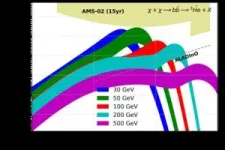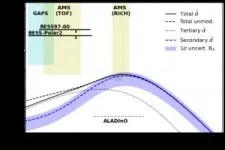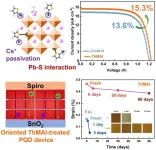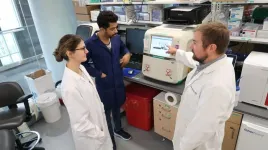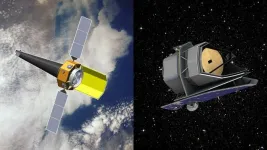(Press-News.org) One of the great challenges of modern cosmology is to reveal the nature of dark matter. We know it exists (it constitutes over 85% of the matter in the Universe), but we have never seen it directly and still do not know what it is. A new study published in JCAP has examined traces of antimatter in the cosmos that could reveal a new class of never-before-observed particles, called WIMP (Weakly Interacting Massive Particles), which could make up dark matter. The study suggests that some recent observations of "antinuclei" in cosmic rays are consistent with the existence of WIMPs, but also that these particles may be even stranger than previously thought.
"WIMPs are particles that have been theorized but never observed, and they could be the ideal candidate for dark matter," explains Pedro De la Torre Luque, a physicist at the Institute of theoretical physics in Madrid other and other particles only through gravity and the weak interaction force, one of the four fundamental forces that operates only at very close distances."
A few years ago, the scientific community hailed a "miracle": WIMPs seemed to meet all the requirements for dark matter, and it was thought—once it was "imagined" what they could be and how they could be detected—that within a few years we would have the first direct evidence of their existence. On the contrary, research in recent years has led to the exclusion of entire classes of these particles, based on their peculiar emissions. Today, although their existence has not been entirely ruled out, the range of possible WIMP types has narrowed significantly, along with the methodologies for trying to detect them. "Of the numerous best-motivated proposed models, most have been ruled out today and only a few of them survive today," says De la Torre Luque.
A recent discovery, however, seems to have reopened the case. "These are some observations from the AMS-02 experiment," De la Torre Luque explains. AMS-02 (Alpha Magnetic Spectrometer) is a scientific experiment aboard the International Space Station that studies cosmic rays. "The project leaders revealed that they detected traces of antinuclei in cosmic rays, specifically antihelium, which no one expected."
To understand why these antinuclei are important for WIMPs and dark matter, one must first understand what antimatter is.
Antimatter is a form of matter with electrical charge opposite to that of "normal" matter particles. If you've followed physics lessons in school, you'll know that ordinary matter, the stuff around us, is made up of particles with negative electric charge, like electrons, positive charge (protons), or neutral charge. Antimatter is composed of "mirror" particles with opposite charges (a "positive" electron, the positron, a "negative" proton, etc.). When matter and antimatter meet, they annihilate each other, emitting strong gamma radiation. In our universe, composed overwhelmingly of normal matter, there is a small amount of antimatter, sometimes closer than one might think, given that positrons are used as contrast agents for PET, the medical imaging exam that some of you may have undergone.
Some of this antimatter was formed—scientists believe—during the Big Bang, but more is constantly created by specific events, which makes it very significant to observe. "If you see the production of antiparticles in the interstellar medium, where you expect very little, it means something unusual is happening," De la Torre Luque explains. "That's why the observation of antihelium was so exciting."
What produces the antihelium nuclei observed by AMS-02 could indeed be WIMPs. According to the theory, when two WIMP particles meet, in some cases they annihilate, meaning they destroy each other, emitting energy and producing both matter and antimatter particles. De la Torre Luque and his colleagues have tested some of the WIMP models to see if they are compatible with the observations.
The study confirmed that some observations of antihelium are hard to explain with known astrophysical phenomena. "Theoretical predictions suggested that, even though cosmic rays can produce antiparticles through interactions with gas in the interstellar medium, the amount of antinuclei, especially antihelium, should be extremely low," De la Torre Luque explains. "We expected to detect one antihelium event every few tens of years, but the around ten antihelium events observed by AMS-02 are many orders of magnitude higher than the predictions based on standard cosmic-ray interactions. That's why these antinuclei are a plausible clue to WIMP annihilation."
But there may be more. The antihelium nuclei observed by AMS-02 are of two distinct isotopes (the same element, but with a varying number of neutrons in the nucleus), antihelium-3 and antihelium-4. Antihelium-4, in particular, is much heavier and also much rarer.
We know that the production of heavier nuclei becomes increasingly unlikely as their mass increases, especially through natural processes involving cosmic rays, which is why seeing so many of them is a warning sign. "Even in the most optimistic models, WIMPs could only explain the amount of antihelium-3 detected, but not antihelium-4," De la Torre Luque continues, and this would require imagining a particle (or class of particles) even stranger than the WIMPs proposed so far, or in technical jargon, even more "exotic."
Thus, De la Torre Luque and his colleagues' study indicates that the path toward WIMPs is not yet closed. Many more precise observations are now needed, and we may have to expand or adapt the theoretical model, perhaps introducing a new dark sector into the standard model of known particles to date, with new "exotic" elements.
END
Glimmers of antimatter to explain the "dark" part of the universe
Traces of antimatter in cosmic rays reopen the search for 'WIMPs' as dark matter
2024-10-04
ELSE PRESS RELEASES FROM THIS DATE:
Kids miss out on learning to swim during pandemic, widening racial and ethnic disparities
2024-10-04
Nearly three out of four kids in Chicago had no swimming lessons in summer of 2022, with significant racial and ethnic differences, according to a parent survey from Ann & Robert H. Lurie Children’s Hospital of Chicago published in Pediatrics. Black and Hispanic/Latine kids were disproportionately affected (85 percent and 82 percent, respectively), compared to white kids (64 percent).
The most common reasons for not getting swimming lessons also differed among racial and ethnic groups. Parents of White kids reported they ...
DGIST restores the performance of quantum dot solar cells as if “flattening crumpled paper!”
2024-10-04
□ Professor Jongmin Choi’s team from the Department of Energy Science and Engineering at DGIST (President Kunwoo Lee) conducted joint research with Materials Engineering and Convergence Technology Professor Tae Kyung Lee from Gyeongsang National University and Applied Chemistry Professor Younghoon Kim from Kookmin University. The researchers developed a new method to improve both the performance and the stability of solar cells using “perovskite quantum dots.” They developed longer-lasting solar cells by addressing the issue of distortions on the surface of quantum dots, which deteriorate the ...
Hoarding disorder: ‘sensory CBT’ treatment strategy shows promise
2024-10-04
Rehearsing alternative outcomes of discarding through imagery rescripting shows promise as a treatment strategy for people who hoard, a study by UNSW psychology researchers has shown.
Hoarding disorder is a highly debilitating condition that worsens with age. People who hoard form intense emotional attachments to objects, accumulate excessive clutter, and have difficulty discarding possessions. Many avoid treatment.
People who hoard also experience more frequent, intrusive and distressing mental images in their daily lives, says Mr Isaac Sabel from the Grisham Research Lab, an experimental clinical psychology research group at UNSW Sydney.
“Negative ...
Water fluoridation less effective now than in past
2024-10-04
The dental health benefits of adding fluoride to drinking water may be smaller now than before fluoride toothpaste was widely available, an updated Cochrane review has found.
The team of researchers from the Universities of Manchester, Dundee and Aberdeen reviewed the evidence from 157 studies which compared communities that had fluoride added to their water supplies with communities that had no additional fluoride in their water. They found that the benefit of fluoridation has declined since the 1970s, when fluoride toothpaste became more widely available.
The contemporary studies were conducted in high-income countries. The impact of community water fluoridation ...
Toddlers get nearly half their calories from ultra-processed foods
2024-10-04
Toddlers in the UK obtain nearly half (47%) of their calories from ultra-processed foods (UPFs), and this rises to 59% by the age of seven, according to a new study led by UCL researchers.
The study, published in the European Journal of Nutrition, looked at data from 2,591 children born in the UK in 2007 and 2008 whose parents recorded what their children ate and drank over three days.
The most common UPFs consumed by the toddlers – who were 21 months when their parents recorded their diets – were flavoured ...
Detroit researchers to examine links between bacterial infections, environmental pollution and preterm birth
2024-10-03
DETROIT — A new grant will help Wayne State University researchers explore the links between bacterial infections, the environmental factors that increase their susceptibility and the risk of preterm birth.
The five-year, $2,858,821 grant from the National Institute of Environmental Health Sciences of the National Institutes of Health, “PFAS increases susceptibility to infection-mediated preterm birth,” will be led by Michael Petriello, Ph.D., assistant professor in Wayne State’s Institute of Environmental Health Sciences and Pharmacology in the School of Medicine.
Petriello hopes that the team’s studies will identify critical pathways responsible ...
In lab tests, dietary zinc inhibits AMR gene transmission
2024-10-03
Highlights:
Antimicrobial resistance is a growing threat.
Bacteria exchange AMR genes in the gut via circular genetic material called plasmids.
In lab experiments, bacteria transferred plasmids with AMR genes in the presence of zinc at reduced or nonexistent rates.
Stopping the transfer without killing microbes may help reduce AMR without disrupting the gut microbiome.
Washington, D.C.—Genes responsible for antimicrobial resistance (AMR) can spread from microbe to microbe through circular genetic material called plasmids, and ...
Two UMD Astronomy space probes advance to next round of $1 billion NASA mission selection
2024-10-03
On October 3, 2024, NASA announced that two space probes proposed by University of Maryland astronomers have advanced to the next round of consideration for a $1 billion mission slated to launch into orbit in 2032.
The selected probes include the Advanced X-ray Imaging Satellite (AXIS) mission with UMD Astronomy Professor Christopher Reynolds as its principal investigator and the PRobe far-Infrared Mission for Astrophysics (PRIMA) with UMD Astronomy Professor Alberto Bolatto as a co-investigator and NASA Goddard Space Flight Center researcher and UMD Astronomy ...
New MSU research sheds light on impact and bias of voter purging in Michigan
2024-10-03
MSU has a satellite uplink/LTN TV studio and Comrex line for radio interviews upon request.
Images and Podcast
EAST LANSING, Mich. – In recent years, some states have prioritized purging their voter rolls of those who have passed away or moved out of state. During election season, there is often increased discussion about the necessity and impact of these actions. Voter purging can be an important step for creating election integrity, but others have raised concerns about how the process is conducted and who it targets.
So, are there negative effects of voter purging? Researchers from Michigan State University wanted to find out — especially ...
Funding to create world's first ovarian cancer prevention vaccine
2024-10-03
In this study, the Cancer Research UK-funded scientists will establish the targets for the vaccine. They will find out which proteins on the surface of early-stage ovarian cancer cells are most strongly recognised by the immune system and how effectively the vaccine kills mini-models of ovarian cancer called organoids.
If this research is successful, work will then begin on clinical trials of the vaccine. The hope is that in the future, women could be offered this vaccine to prevent ovarian cancer in the first place.
There are around 7,500 new ovarian ...
LAST 30 PRESS RELEASES:
Common eye ointment can damage glaucoma implants, study warns
ACCESS-AD: a new European initiative to accelerate timely and equitable AD diagnosis, treatment and care
Mercury exposure in northern communities linked to eating waterfowl
New Zealand researchers identify brain link to high blood pressure
New research confirms people with ME/CFS have a consistent faulty cellular structure
Hidden cancer risk behind fatty liver disease targets
Born in brightness, leading to darkness
Boron-containing Z-type and bilayer benzoxene
Hong Kong researchers break the single-field barrier with dual-field assisted diamond cutting
Work hard, play hard?
Wood becomes smart glass: Photo- and electro-chromic membrane switches tint in seconds
The Lancet: COVID-19 vaccine hesitancy decreased over time, though mistrust persists among certain groups, study of over 1 million people in England suggests
Psychosis patients ‘living in metaphor’ -- new study radically shifts ideas about delusions
Clinical trial in Ethiopia targets the trachoma scourge
Open-sourcing the future of food
Changes in genetic structure of yeast lead to disease-causing genomic instabilities
UC San Diego Health Sciences Grant Writing Course helps launch successful research careers
Study: Many head and neck cancer trials end early. Why?
Tufts vice provost for research named Foreign Fellow of Indian National Science Academy
New model improves prediction of prostate cancer death risk
Two wrongs make a right: how two damaging variants can restore health
Overlooked decline in grazing livestock brings risks and opportunities
Using rare sugars to address alcoholism
Research alert: New vulnerability identified in aggressive breast cancer
Ruth Harris honored with SSA Distinguished Service Award
Treasure trove of data on aging publicly accessible
Trees4Adapt project to address risks from climate change and biodiversity loss through tree-based solutions
Nature Communications study from the Lundquist Institute identifies molecular mechanism underlying peripartum cardiomyopathy
Pennington Biomedical’s Dr. Gang Hu appointed to NIH Reproductive, Perinatal and Pediatric Health Review Group
World-first project shows great promise to treat low eye pressure
[Press-News.org] Glimmers of antimatter to explain the "dark" part of the universeTraces of antimatter in cosmic rays reopen the search for 'WIMPs' as dark matter
